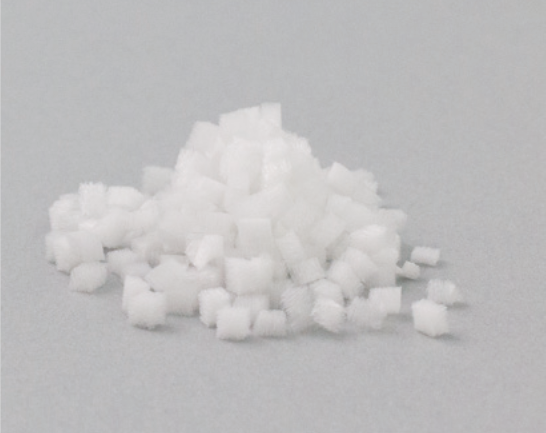Atelocollagen Honeycomb Sponge (blocks)
KKN-CSH-10
Brand: AteloCell
Lyophilized Atelocollagen sponge shows a honeycomb structure with high pore density and unidirectional characteristics. This honeycomb structure enables easy delivery of nutrients to cells, and transport of excreted waste products away from cells.

Currency:
| Product name | Product code | Pack size | Price (USD) | Price (GBP) | Price (EUR) |
|---|---|---|---|---|---|
| Atelocollagen Honeycomb Sponge (blocks) | KKN-CSH-10 | 100 mg | $ 728.00 | £ 718.00 | € 840.00 |
Note: prices shown do not include shipping and handling charges.
Product Information
The 'Honeycomb' collagen sponge has a structure in which uniform pores (250-400 um) are arranged densely in one direction, into which cells can penetrate and proliferate. This structure facilitates the ready supply of nutrients to the cells inside the sponge, and releases metabolic wastes and biochemical products. Cells can proliferate and fill the lumen to form a uniform cell mass. The 'Honeycomb' collagen sponge is prepared from highly purified bovine dermal type I Atelocollagen and can be degraded by collagenase.

Suppression of tumorigenesis from transplanted mouse ES cells by cultivation with Atelocollagen Honeycomb Sponge. (M. Yamaki, Matsumoto Dental University, Japan)
Mouse ES cells cultured on honeycomb sponge were transplanted by subcutaneous injection into 6-week-old mice. Although all embryoid bodies without the honeycomb sponge formed tumor without exception, none of the embryoid bodies transplanted with the honeycomb sponge formed tumors (Fig.1).
Histological analysis of transplanted (mouse ES/+CSH) and normal kidney showed no differences between the two tissues. The results indicates normal spontaneous differentiation of the mouse ES cells in the presence of the honeycomb sponge when transplanted in vivo (Fig.2).

KOKEN company name and logo and AteloCell brand are the property of KOKEN Corp. Ltd., Japan.
Product Name: Atelocollagen Honeycomb Sponge
Catalog Number: KKN-CSH-10
Size: 100 mg (bottle)
Sponge Dimensions
- 3 × 3 × 2 mm sponges
- 12-13 mg/mL density
- 200-400 µm pore size
- approx. 2000 cm² / g surface area
Storage and Stability: Store at Room Temperature
Sterility: Sterile
Notice To Purchaser: REPROCELL is a licensed global distributor of KOKEN’s collagen-derived products everywhere, except for Japan.
Manufacturer: Koken Co., Ltd. (Japan)
Specification Sheets:
- Zaminy A, et al. Mesenchymal stem cells as an alternative for Schwann cells in rat spinal ord injury. (2013) Iran Biomed J. 17(3):113-122.
- Buser Z, et al. Inflammatory response of intervertebral disc cells is reduced by fibrin sealant scaffold in vitro. (2012) J Tissue Eng Regen Med. [Epub ahead of print]
- Guo Z, et al. Three-Dimensional Geometry of Honeycomb Collagen Promotes Higher Beating Rate of Myocardial Cells in Culture. (2012) Artif Organs. 36(9):816-819.
- Ishii I, et al. Correlation between antizyme 1 and differentiation of vascular smooth muscle cells cultured in honeycomb-like type-I collagen matrix. (2012) Amino Acids. 42(2-3):565-575.
- Suzuki T, et al. Growth inhibition and differentiation of cultured smooth muscle cells depend on cellular crossbridges across the tubular lumen of type I collagen matrix honeycombs. (2009) Microvasc Res. 77(2):143-149.
- Fukushima K, et al. The axonal regeneration across a honeycomb collagen sponge applied to the transected spinal cord. (2008) J Med Dent Sci. 55(1):71-79.
- Imamura T, et al. Three-dimensional culture systems for differentiation of mice embryonic stem cells into hepatocyte-like cells. (2008) J Organ Dysfunct. 4(1):57-64.
- Kakudo N, et al. Bone tissue engineering using human adipose-derived stem cells and honeycomb collagen scaffold. (2008) J Biomed Mater Res A. 84(1):191-197.
- Saeki K, et al. Highly efficient and feeder-free production of subculturable vascular endothelial cells from primate embryonic stem cells. (2008) J Cell Physiol. 217(1):261-280.
- Takeuchi R, et al. Low-intensity pulsed ultrasound activates the phosphatidylinositol 3 kinase/Akt pathway and stimulates the growth of chondrocytes in three-dimensional cultures: a basic science study. (2008) Arthritis Res Ther. 10(4):R77.
- Hidetsugu T, et al. Mechanism of bone induction by KUSA/A1 cells using atelocollagen honeycomb scaffold. (2007) J Biomed Sci. 14(2):255-263.
- George J, et al. Differentiation of mesenchymal stem cells into osteoblasts on honeycomb collagen scaffolds. (2006) Biotechnol Bioeng. 95(3):404-411.
- Imamura T, et al. Embryonic stem cell-derived embryoid bodies in three-dimensional culture system form hepatocyte-like cells in vitro and in vivo. (2004) Tissue Eng. 10(11-12):1716-1724.
- Itoh H, et al. A honeycomb collagen carrier for cell culture as a tissue engineering scaffold. (2001) Artif Organs. 25(3):213-217.
- Moriyama T, et al. Development of composite cultured oral mucosa utilizing collagen sponge matrix and contracted collagen gel: a preliminary study for clinical applications. (2001) Tissue Eng. 7(4):415-427.
